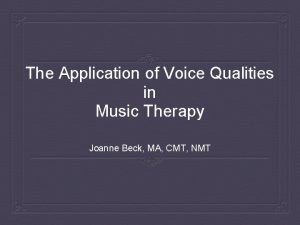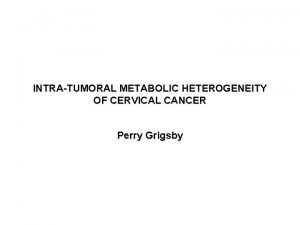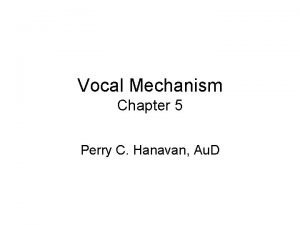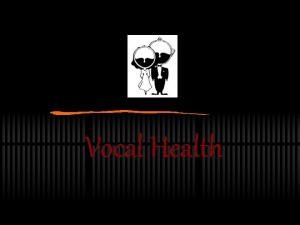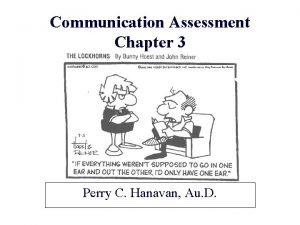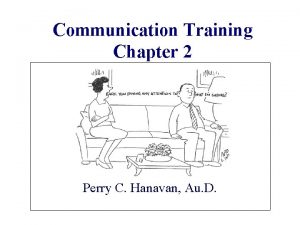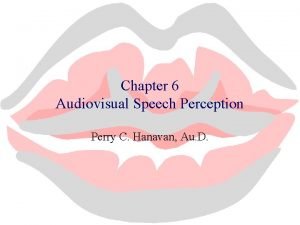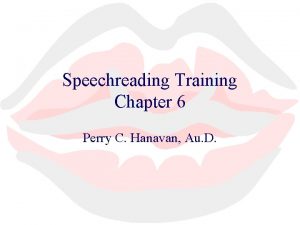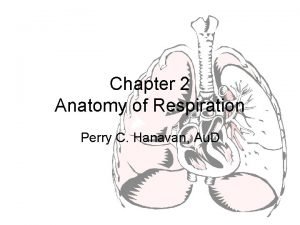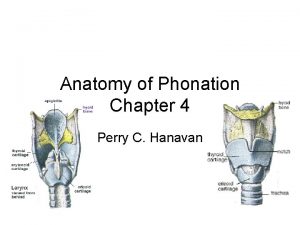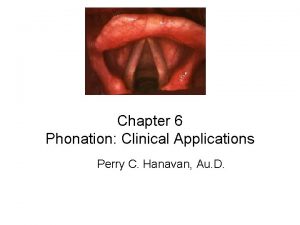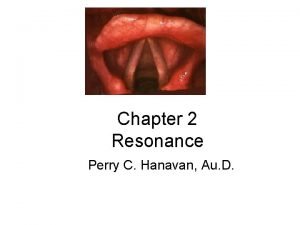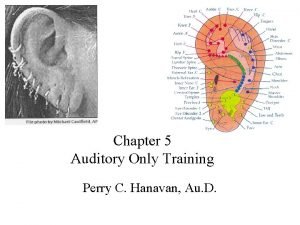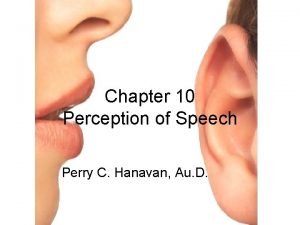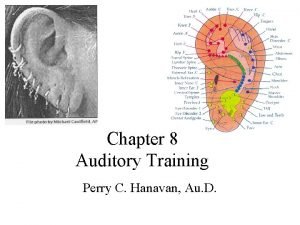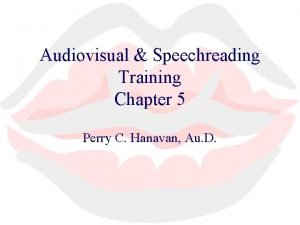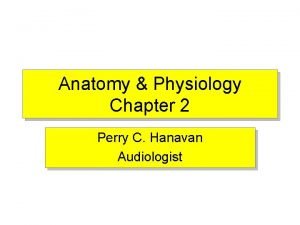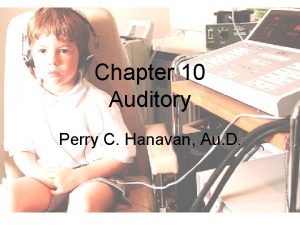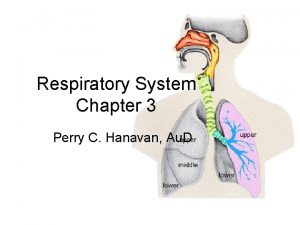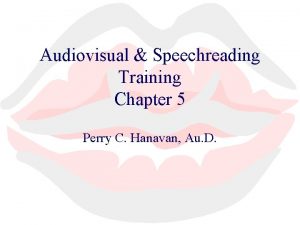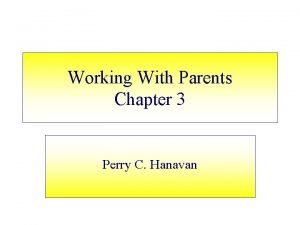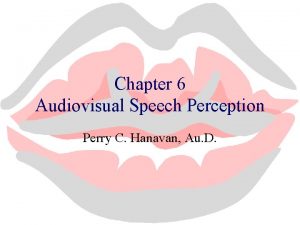Chapter 5 Vocal Mechanism Perry C Hanavan Au

































- Slides: 33

Chapter 5 Vocal Mechanism Perry C. Hanavan, Au. D

Question The larynx is the: A. Voice box B. Throat C. Esophagus D. Nasal passage E. Oral cavity

Phonatory System

Larynx

The only bone of the larynx is: A. Thyroid B. Cricoid C. Arytenoid(s) D. Epiglottis E. Hyoid

Larynx

The vocalis muscle attaches to: A. Thyroid B. Cricoid C. Arytenoid(s) D. B and C E. A and C

The largest cartilage is the: A. Thyroid B. Cricoid C. Arytenoid(s) D. Mandible E. Hyoid

Larynx

To close or bring together: A. Abduct B. Adduct C. Neither

Vocal Folds

Muscles of Larynx • Extrinsic – Have one point of attachment to larynx and other attachment other structure • Intrinsic – Have origin and insertion within larynx

The vocalis is an ____ laryngeal muscle: A. Extrinsic B. Intrinsic C. Both D. Neither

Myoelastic-Aerodynamic Theory • Model describing voice production (phonation) as a combination of: – Muscle force (myo) – Tissue elasticity (elasticity) – Pressures and flows (aerodynamic) – Bernoulli principle

Mucosal Wave • Examples – Mucosal Wave – Asymmetrical Mucosal Wave – Spasmodic dysphonia

Mucosal Wave • Vertical phase difference • Longitudinal phase difference

Question The Bernoulli principle: A. B. C. D. E. F. As velocity increases, pressure decreases As velocity decreases, pressure increases As velocity increases, pressure increases As velocity decreases, pressure decreases A and B are true C and D are true

Bernoulli Principle • As flow increases, pressure decreases – Subglottal air pressure increases and forces vocal folds to abduct – Rapid flow of air through glottal space decreases pressure in the glottis and vocal folds close

Phonation: Glottal Spectrum • Determined by mass, length, and tension • Changes throughout utterance (question vs. statement, etc. ) • Males Fo (80 -150) • Females Fo (180 -250) • Children Fo (250 -300)

Glottal Spectrum • Glottal Fo with harmonics • Does not represent what is heard due to vocal tract modulation • The Fo corresponds to the perceived pitch of the voice • The harmonics contribute to the quality of the voice

Fo & Harmonic Spacing • Adult Male • Adult Female • Child

Roll Off--Fo

Question Who has the largest harmonic spaces (distance between harmonics)? A. Males B. Females C. Young girls D. Young boys E. C & D

Harmonic Variations • Cycle-to-cycle variations in frequency and amplitude can occur from several factors: – Neurologic – Biomechanic – Aerodynamic – Hearing loss (inadequate feedback system)

FO & Hearing Loss • Leder SB, Spitzer JB, Kirchner JC. Ann Otol Rhinol Laryngol. 1987 May-Jun; 96(3 Pt 1): 322 -4. – Speaking fundamental frequency of postlingually profoundly deaf adult men. Investigated speaking fundamental frequency (F 0) of 21 postlingually profoundly sensorineurally deaf males • Speaking F 0 was significantly higher for the deaf group than for normal-hearing, age-matched men. • Neither duration of profound deafness nor hearing aid usage affected speaking F 0 values significantly.

Hearing vs. Hearing Loss J Acoust Soc Am. 1982 Jan; 71(1): 196 -202. Long-term average speech spectra for normal and hearing-impaired adolescents. Monsen RB. Spectra characterized by regular pattern of peaks occurring at multiples of the talkers' fundamental frequencies and by slopes declining at rates of -5 to -6 d. B/octave. Adolescents with HL produced spectra for which the harmonic structure ranged from very well defined to the irregular and poorly defined; spectral slopes declined at rates equal to or greater than the normal rate, in some cases declining at twice the normal rate.

Hearing vs. Cochlear Implant OBJECTIVE: The different speech sounds are formed by the primary voice signal and by the shape of the articulation tract. With this mechanism, specific overtones, the formants, are generated for each vowel. The objective of this study was to investigate the fundamental frequency (F 0) of the voice signal and the first three formants (F 1 -F 3) as a parameter of the articulation in prelingually deafened children at different timepoints after cochlear implantation (CI) compared with children with normal speech development. CONCLUSIONS: Prelingually deaf children who receive a CI before fourth birthday attain better acoustic control over speech, normalizing fundamental frequencies and improving their articulatory skills. Int J Pediatr Otorhinolaryngol. 2002 Nov 11; 66(2): 115 -23. Changes of voice and articulation in children with cochlear implants. Seifert E, Oswald M, Bruns U, Vischer M, Kompis M, Haeusler R.

Post CI & TC Ear Hear. 2003 Feb; 24(1): 48 -70. Longitudinal changes in children's speech and voice physiology after cochlear implantation. Higgins MB, Mc. Cleary EA, Carney AE, Schulte L. OBJECTIVES: The purposes of this investigation were 1) to describe speech/voice physiological characteristics of prelingually deafened children before and after cochlear implantation and determine whether they fall into a range that would be considered deviant, 2) to determine whether selected deviant articulatory and phonatory behaviors of children with cochlear implants persist despite long-term cochlear implant use and continued participation in aural rehabilitation services, and 3) to determine whether further development of deviant articulatory and phonatory behaviors occurs postimplantation. CONCLUSIONS: Children who received cochlear implants after 5 yrs of age and who were educated in a Total Communication setting showed persistence and further development of deviant speech/voice behaviors for several years post-cochlear implant. Although our findings cannot be generalized to other populations of children with cochlear implants (i. e. , those who were implanted earlier, those educated in auditory-oral programs), it seems wisest at the present time not to assume that children's deviant speech/voice behaviors will remit spontaneously with continued cochlear implant use.

Which is true? A. B. C. D. E. F. Speaking F 0 was significantly higher for the late deafened group than for normal-hearing Children who received CIs and educated in a TC setting showed further development of speech/voice behaviors for several years post-CI. Prelingually deaf children who receive a CI before fourth birthday attain better acoustic control over their speech, normalizing their fundamental frequencies Adolescents with hearing loss produced spectra for which the harmonic structure ranged from the very well defined to the irregular and poorly defined; spectral slopes declined at rates equal to or greater than the normal rate All false All true

Voice Disorders • jitter – cycle to cycle variability in frequency of vocal fold vibration also called frequency perturbation • shimmer – cycle to cycle variability in amplitude of vocal fold vibration also called amplitude perturbation

Which is jitter? A. cycle to cycle variability in frequency of true vocal fold vibration also called frequency perturbation B. cycle to cycle variability in amplitude of vocal fold vibration also called amplitude perturbation C. cycle to cycle variability in frequency of false vocal fold vibration also called frequency perturbation D. cycle to cycle variability in amplitude of false vocal fold vibration also called amplitude perturbation

Noise series Jitter + noise series Jitter only series Shimmer + noise series Shimmer only series

Polyps • Polyps video
 False and true vocal cords
False and true vocal cords Similarities of vocal styles of india and israel
Similarities of vocal styles of india and israel Kalani craig
Kalani craig Perry glasser
Perry glasser Words that rhyme with katy
Words that rhyme with katy Dr richard perry
Dr richard perry Like thunder gonna shake the ground meaning
Like thunder gonna shake the ground meaning Commodore matthew perry apush
Commodore matthew perry apush Reece map
Reece map William g. perry
William g. perry Was there really a trojan war
Was there really a trojan war Perry como sunrise, sunset
Perry como sunrise, sunset Imagery in the song roar
Imagery in the song roar Perry’s theory of intellectual and ethical development
Perry’s theory of intellectual and ethical development Lee burdette williams
Lee burdette williams Dr. perry sugar
Dr. perry sugar Perry grigsby
Perry grigsby Trans siberian railroad definition ap world history
Trans siberian railroad definition ap world history Katy perry firework figurative language
Katy perry firework figurative language Brian perry lawyer
Brian perry lawyer Ivan perry
Ivan perry Perry high school marching band
Perry high school marching band Spay perry county
Spay perry county Perry babb
Perry babb Katy perry relient k
Katy perry relient k Patrick geddes
Patrick geddes Dr perry liu
Dr perry liu Dr richard perry neurologist
Dr richard perry neurologist First word on the cross
First word on the cross Josephine david perry
Josephine david perry Gabby perry
Gabby perry Kuhn perry
Kuhn perry Creative commons license
Creative commons license Perry zinn rowthorn
Perry zinn rowthorn
